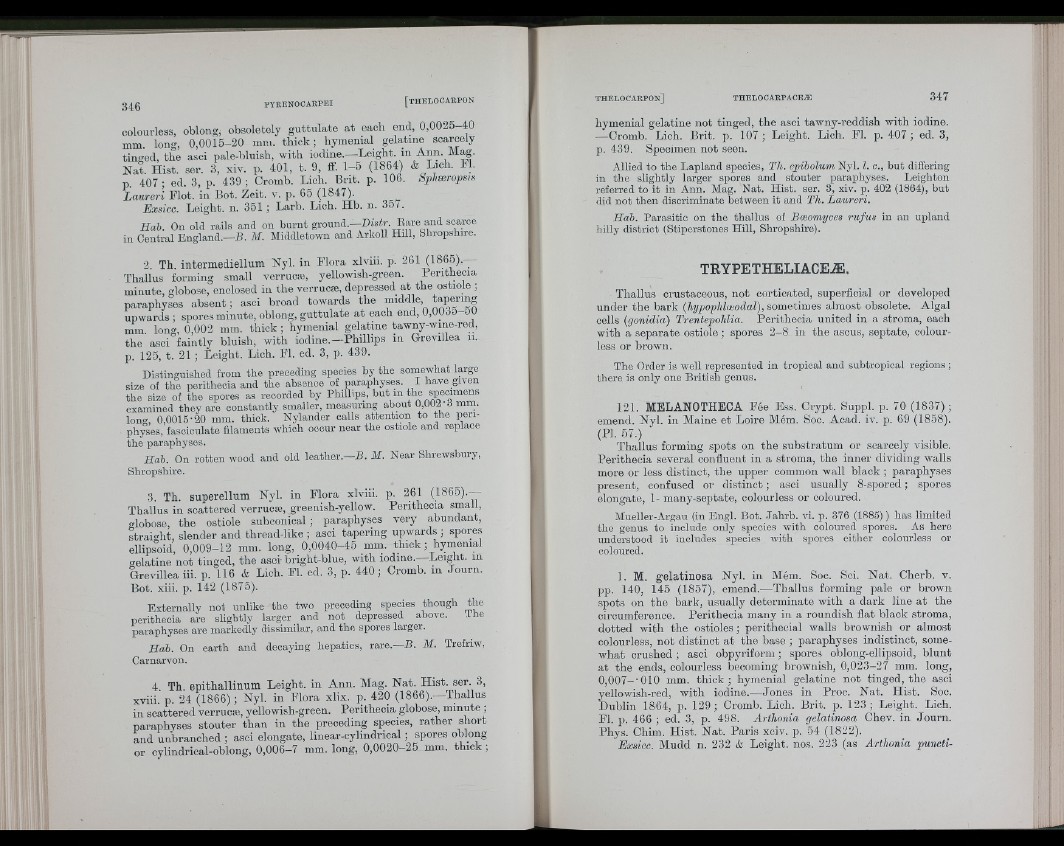
colourless, oblong; obsoletely guttulate a t each end, 0,0025-40
mm. long, 0,0015-20 mm. tliick ; hymenial gela,tine scarcely
tinged, the asci pale-bluish, with iodine.—Leight. m Ann. Mag.
Nat. Hist. ser. 3, xiv. p. 401, t. 9, ff. 1-5 (1864) & Kch. hi.
p. 407 ; ed. 3, p. 439 ; Cromb. Lich. Brit. p. 106. Sphseropsis
Laureri Flot. in Bot. Zeit. v. p. 65 (1847).
Exsicc. Leight. n. 351 ; Larb. Lich. Hb. n. 357.
Hah. On old rails and on burnt g r o u n d . — Rtsir. Bare and scarce
in Central England.—R. M. Middletown and Arkoll Hill, Shropshire.
2. Th. intermediellum Nyl. in Flora xlvni. p. 261 (1865).—
Thallus forming small verrucæ, yellowish-green. Perithecia
minute, globose, enclosed in the verrucæ, depressed a t the ostiole ;
paraphyses ab sen t; asci broad towards the f«*dle tapering
Upwards ; spores minute, oblong, guttulate a t each end, 0,UUoo oU
mm long, 0,002 mm. thick ; hymenial gelatine tawny-wine-red,
the asci faintly bluish, with iodine.—Phillips in Grevillea ii.
p. 125, t. 21 ; Leight. Lich. Fl. ed. 3, p. 439.
Distinguished from the preceding species by the somewhat large
size of the perithecia and the absence of paraphyses. I have given
the size of the spores as recorded by Phillips, but m the specimens
examined they are constantly smaller, measuring about 0,002 3 mm.
long, 0,0015-20 mm. thick. Nylander calls attention to the peii-
physes, fasciculate filaments which occur near the ostiole and replace
the paraphyses.
Hab. On rotten wood and old leather.—R. M. Near Shrewsbury,
Shropshire.
3. Th. superellum Nyl. in Flora xlviii. p. 261 (1865).—
Thallus in scattered verrucæ, greenish-yellow. Perithecia small,
globose, the ostiole subconical; paraphyses very abundant,
I r a ig h t, slender and thread-like ; asci tapering upwards ; spores
ellipsoid, 0,009-12 mm. long, 0,0040-45 mm. thick ; hymenial
o-elatine not tinged, the asci- bright-blue, with iodine.—Leight. in
Grevillea iii. p. 116 & Lich. Fl. eel. 3, p. 440; Cromb. in Journ.
Bot. xiii. p. 142 (1875).
Externally not unlike the two preceding species though the
perithecia are slightly larger and not depressed above. Hie
paraphyses are markedly dissimilar, and the spores larger.
Hab. On earth and decaying hepatics, rare.—R. M. Trefriw,
Carnarvon.
4. Th. epithallinum Leight. in Ann. Mag. Nat. Hist, ser 3,
xviii. p. 24 (1866) ; Nyl. in Flora xlix. p. 420 (1866).—Thallus
in scattered verrucæ, yellowish-green. Perithecia globose, minute ;
paraphyses stouter th an in th e preceding species, rather short
and unbranched ; asci elongate, linear-cylindrical ; spores oblong
or cylindrical-oblong, 0,006-7 mm. long, 0,0020-25 mm. th ic k ;
hymenial gelatine not tinged, the asci tawny-reddish with iodine.
—Cromb. Lich. Brit. p. 107 ; Leight. Lich. Fl. p. 407 ; ed. 3,
p. 439. Specimen not seen.
Allied to the Lapland species, Th. epiholum Nyl. I. c., but differing
in the slightly larger spores and stouter paraphyses. Leighton
referred to it in Ann. Mag. Nat. Hist. ser. 3, xiv. p. 402 (1864), but
did not then discriminate between it and Th. Laureri.
Hab. Parasitic on the thallus of Boeomyces rufus in an upland
hilly district (Stiperstones Hill, Shropshire).
T R Y P E T H E L IA C EÆ .
Thallus crustaceous, not corticated, superficial or developed
under the bark (hypophloeodal), sometimes almost obsolete. Algal
cells (gonidia) Trentepohlia. Perithecia united in a stroma, each
with a separate ostiole ; spores 2-8 in the ascus, septate, colourless
or brown.
The Order is well represented in tropical and subtropical regions ;
there is only one British genus.
121. MELANOTHECA Fée Ess. Crypt. Suppl. p. 70 (1837);
emend. Nyl. in Maine et Loire Mém. Soc. Acad. iv. p. 69 (1858).
(PI. 57.)
Thallus forming spots on the substratum or scarcely visible.
Perithecia several confluent in a stroma, the inner dividing walls
more or less distinct, the upper common wall black ; paraphyses
present, confused or distinct ; asci usually 8-spored ; spores
elongate, 1- many-septate, colourless or coloured.
Mueller-Argau (in Engl. Bot. Jahrb. vi. p. 376 (1885) ) has limited
the genus to include only species with coloured spores. As here
understood it includes species with spores either colourless or
coloured.
1. M. gelatinosa Nyl. in Mém. Soc. Sci. Nat. Cherb. v.
pp. 140, 145 (1857), emend.—Thallus forming pale or brown
spots on the bark, usually determinate with a dark line a t the
circumference. Perithecia many in a roundish flat black stroma,
dotted with the ostioles; peritheciai walls brownish or almost
colourless, not distinct a t the base ; paraphyses indistinct, somewhat
crushed ; asci obpyriform ; spores oblong-ellipsoid, blunt
a t the ends, colourless becoming brownish, 0,023-27 mm. long,
0,007--010 mm. th ic k ; hymenial gelatine not tinged, the asci
yellowish-red, with iodine.—Jones in Proc. Nat. Hist. Soc.
Dublin 1864, p. 129; Cromb. Lich. Brit. p. 123; Leight. Lich.
El. p. 466 ; ed. 3, p. 498. Arthonia gelatinosa Chev. in Journ.
Phys. Chim. Hist. Nat. Paris xciv. p. 54 (1822).
Exsicc. Mudd n. 232 & Leight. nos. 223 (as Arthonia puncti